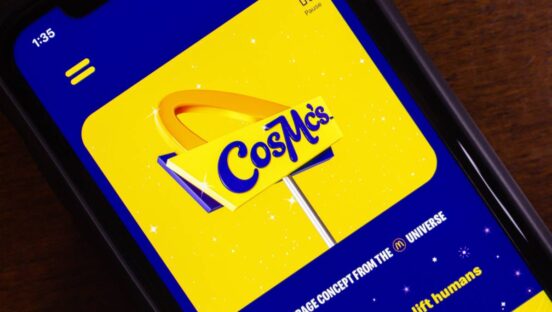There’s been a lot written on the model and methodology of McDonald’s beverage offshoot, CosMc’s. Not to mention countless social anecdotes of lines stretching through the lot, which has required police presence at times and the use of a separate parking lot to accommodate vehicles. While more is sure to emerge on the concept’s performance, foot traffic platform Placer.ai recently took a trip to the Bolingbrook, Illinois, destination to get a sense of the experience, as well as run data on what’s unfolded thus far.
The company’s data suggests CosMc’s saw more than double the number of visits than a typical McDonald’s recorded nationwide in December (even getting started on December 7). It also generated over triple the number of visits per square foot; the brand is roughly 2,500 square feet smaller than traditional stores.
Placer.ai said, however, it’s worth noting CosMc’s visitation numbers would likely have been much higher even if the location had additional capacity to satisfy demand.
The company deployed some additional methods to evaluate how CosMc’s performed. Based on 2019 Census Block Group data, CosMc’s trade area size (using a 70 percent of visit threshold) was just more than 155 square miles in December. Or, roughly 2.5 times the size of the trade area for the average McDonald’s location (62 miles) and significantly larger than average trade areas for most coffee brands (25–35 miles for more urban-focused chains and 50–60 miles for suburban/secondary market brands).

RJ Hottovy, the head of analytic research at Placer.ai, said the closest comparison they could find for CosMc’s, which had some 80 cars stacked up when they arrived, was the Post Malone and Dallas Cowboys Raising Cane’s collaborations that sprung up in recent months. The latter had a 264-mile trade area during its debut month, helped by cross-traffic from Cowboys home games, Hottovy said. In some ways, there were also similarities between CosMc’s and the Hello Kitty Café Trucks. These parked near malls on Saturdays and drew massive crowds, with customers standing in line for hours to get limited-availability treats and merchandise. At one stop in Virginia Beach in March, the mall saw visits soar 164.8 percent compared to its daily average in the first half of the year and nearly 40 percent above typical Saturdays.
With an eclectic menu and clear trend-lines—think Galactic Boosts and Turmeric Spiced Lattes—many pundits circled CosMc’s as McDonald’s nod to the Gen Z generation and acknowledgment of a $100 billion specialty beverage world that’s been cracked wide open by cold innovation. According to Circana, formerly NPD Group, Gen Z made nearly 5 billion restaurant visits in the 12 months ending July 2022. About 4.3 billion of those went to quick service. As Hottovy explains, CosMc’s also sits at the intersection of several other fast-food movements rising in COVID’s wake that tend to skew toward younger guests. For instance, early daypart visits pushing further back due to changes in guest routines, like work from home and hybrid offices, and a resurgence in late-night dining. And technology has wedged into the picture, especially at the drive-thru. CosMc’s boasts dynamic menuboards and cashless payment devices where consumers sit at the board until their order is ready. Pickup windows are assigned when the order is ready. At its inherent core, CosMc’s is a pay-at-the-stall model that lacks human interaction to the degree of other beverage peers, like Starbucks or Dutch Bros. Guests, when their orders are ready, round the corner to pull up, where they receive food in gift-style CosMc’s paper bags.
The restaurant doesn’t boast grills or fryers, either, and the exterior-facing wall is nearly entirely windows. So there are multiple spots to serve cars, but it also presents an open kitchen for customers to view the process.
Placer.ai took a look at the age breakdown to see if CosMc’s has, in fact, drawn in younger demographics in its infancy. The answer is yes—particularly 22- to 29-year-old guests.

As for what’s next, McDonald’s said it plans to open an additional 10 test units, including in the Dallas-Fort Worth and San Antonio markets (another trend on the population migration front; Dutch Bros has about 150 stores there since debuting in January 2021). It’s likely these openings tweak as they roll out and some of the learnings, such as the drive-thru dynamics, find their way into general McDonald’s as well. There’s rumors of AI tests, in one example. “McDonald’s has attempted to differentiate its coffee business in the past with its McCafe menu and standalone McCafe locations in international markets, but competition with Starbucks and others made it difficult for the company to distinguish McCafe as a standalone retail brand in the U.S.,” Hottovy wrote. “CosMc’s is interesting from this perspective, as it may allow the company to build a brand more naturally and stand out with a younger audience, which appears to be working.”
He agreed it’s unlikely future CosMc’s will feel or operate like the pilot store. “Nevertheless, the excitement around new products, an expansive trade area, and potential to connect with younger audience make it a worthwhile test, especially with 2024 shaping up to be a strong year for unit growth within the coffee category,” Hottovy said.
It’ll be a frantic year ahead for McDonald’s regardless of where its most-buzzed about development goes. The chain said in December—its first investor day in three years—it was ready to embark on the “fastest period of growth” in brand history. That should take the industry’s top-earning chain, which closed 2022 with 40,275 restaurants, to 50,000 units by 2027.
McDonald’s projected growth of 9,000 or so locations over that span includes about 900 openings in the U.S., 1,900 in McDonald’s IOM (international operated markets, like France, Australia, and Canada), and 7,000 in its IDL segment (where China is included).
McDonald’s has appreciated 30 percent comparable sales growth since 2019. Comps hiked 8.1 percent in Q3, rolling over 6.1 percent growth in the year-ago period. That after a 10.3 percent rise in Q2 and a 12.6 percent increase in Q1.








